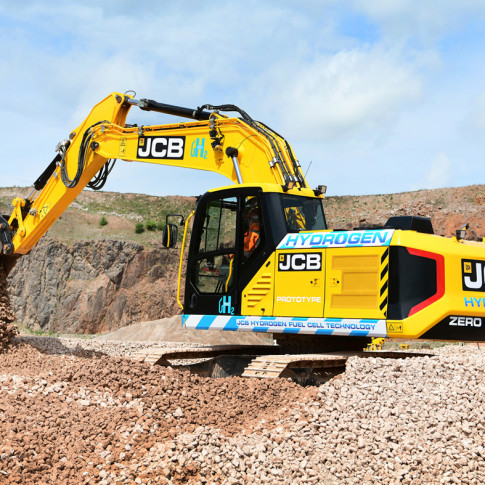Hydrogen Does The Heavy Lifting

Hydrogen set to be the Fuel of the Future for Heavy Construction Equipment
The UK was the first major economy to set a legally binding target to cut greenhouse emissions to net-zero by 2050. In addition, there is a ban on the sale of new traditionally fuelled, diesel and petrol, cars and heavy vehicles from the end of 2030. There is a view that this could well be extended soon to the use of diesel in plant and construction equipment as well.
Whilst smaller equipment can be powered by batteries and, indeed, this can make them more suited to certain applications, such as in confined spaces and where noise levels need to be reduced, at present they are not suitable for larger pieces of plant. This is because they do not have the strength, as well as weight disadvantages, and the time taken to charge is inconvenient when much construction equipment must run continually to cover its cost.
Hydrogen is the most prolific substance in the universe accounting for almost 90% of all matter. It is also the lightest known element in the periodic table. A process of water electrolysis can be used to split water into hydrogen and oxygen by the use of electricity. Hydrogen then provides a very clean source of power with zero carbon emissions. No CO2, HC or NOx and so zero tailpipe emissions.
Hydrogen can be run far leaner and burns reliably at an air-fuel ratio of 100:1. This matters because the leaner hydrogen is burned, the cooler the combustion and the lower the NOx levels produced.
Hydrogen use is developing quickly in road transportation, especially for larger commercial vehicles and buses. These vehicles are again those where long-range and/or operating times (battery life is also much shorter in cold weather) makes hydrogen an alternative and attractive option.
Interestingly, Wright Bus, owned by Jo Bamford, the son of Land Bamford, the owner of JCB, is planning to introduce 3,000 hydrogen buses to the UK. Although costs are high at present, with technological advances and economies of scale they are expected to fall. Another big benefit is that hydrogen vehicles can be refuelled within a few minutes.
Interestingly, in Switzerland, Hyundai, another manufacturer of construction equipment, has started delivery of fuel cell electrical vehicles, with a planned production of 1,600 trucks by the year 2025.
Returning to JCB, the company has already developed a prototype hydrogen engine based on their 4.8 litre four-cylinder unit. New from the cylinder head upwards, a new fuel rail carries compressed hydrogen to direct injectors that are centrally mounted. Meanwhile, a larger, variable geometry turbocharger further assists with power generation. Hydrogen can be easily ignited by unintended sparks and so the 448 hydrogen engine has individual ignition coils on each spark plug, derived from motorsport applications.
Preproduction engines are also to be installed as a straight swap for those in the 3CX Backhoe Loader with the diesel tank being substituted for hydrogen tanks. Installation is relatively straightforward and may easily be retrofitted to diesel machines, with hydrogen being supplied on building sites from mobile tankers, as with diesel today.
At present hydrogen remains more expensive than conventional carbon fuels. This is partly due to the sophisticated technology involved in its production. However, this is reducing fast and the process is expected to improve further. At the same time, the costs of carbon fuels are expected to increase significantly and this is part of the equation that will make hydrogen power more affordable in future.
For Holm, the filter requirements of vehicles are not expected to change significantly. As it is only the cylinder head and associated ancillaries that change, many of the filters required will remain the same. To discuss your current filter requirements, please do not hesitate to phone Holm, send us an email or complete our enquiry form.
